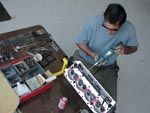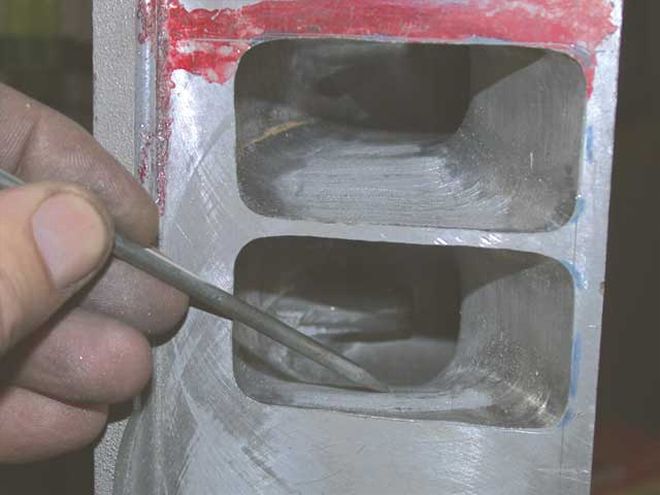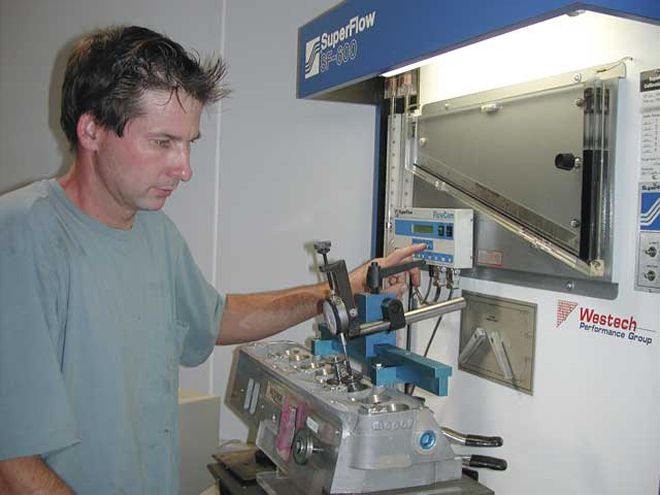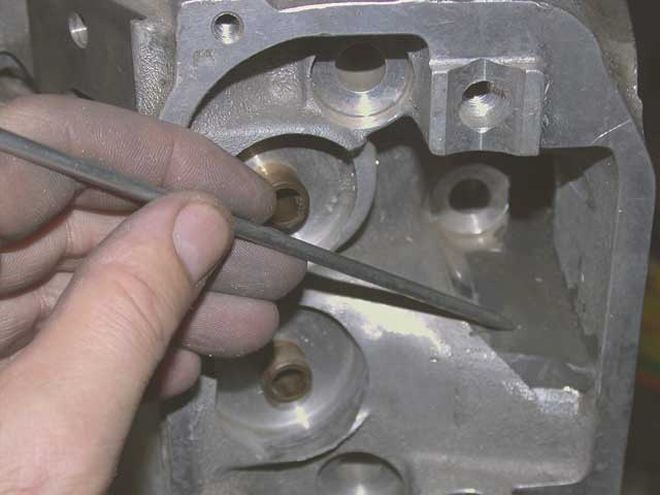
 when we last left our 440 project, we had a complete, bare, .030"-over short block. We set some pretty lofty goals for this 440 build, with a target of about 600 hp and 600 lb.-ft. of torque in a streetable pump-gas package. We were also looking for a decent idle with a target of 12-inches Hg of vacuum. We pointed out that getting near our goals would take a "trick" top end, but we did have some tricks up our sleeve.
when we last left our 440 project, we had a complete, bare, .030"-over short block. We set some pretty lofty goals for this 440 build, with a target of about 600 hp and 600 lb.-ft. of torque in a streetable pump-gas package. We were also looking for a decent idle with a target of 12-inches Hg of vacuum. We pointed out that getting near our goals would take a "trick" top end, but we did have some tricks up our sleeve.
For those who missed the last installment of our Mild-Mannered Mauler440 (Mopar Muscle, March 2005), the idea was a study in engine-buildinggreed. We wanted huge power--on the order of 600 hp at the crank. Wewanted a relatively smooth idle with good vacuum and low-rpmtractability. We wanted copious quantities of torque, in theneighborhood of 600 lb-ft. We wanted low maintenance, and we wanted itall relatively cheap. We wanted the power to come to a peak in thelow-to-mid-6,000-rpm range, and we wanted to do it with a regularstock-stroke 440 with a typical .030-inch overbore. Want, want, want,everyone wants an engine that does it all, but were our goalsunreasonable? Add one more want to the list--we wanted to try and see ifwe could even do it.
Although strokers are the current rage, since thisengine was destined for a street 'Cuda project, we decided that a goodstout 446 cubes would deliver more than the level of low-end torque thatwe could put to the ground on radials. We figured we'd get greater rpmcapacity with the stock cubes, and reap our power upstairs at higher rpmwhere our street combo could use it more effectively. In a light carwith broad gear ratios, we'd probably see better fuel economy with thesmaller engine, which was a consideration. A stock-stroke 440 would suitour needs just fine, and the bottom end would be cheaper to build.
 Our cylinder heads may be familiar to our regular readers since we areusing the Mopar Performance 383/440 aluminum heads that we fully portedto max wedge size in a previous issue. We had achieved peak intake flowof some 315 cfm. We were pretty happy with that level, but want to takeit even further.
Our cylinder heads may be familiar to our regular readers since we areusing the Mopar Performance 383/440 aluminum heads that we fully portedto max wedge size in a previous issue. We had achieved peak intake flowof some 315 cfm. We were pretty happy with that level, but want to takeit even further.
Thereal challenge would be how to get a good idle, good vacuum, anddriveability, while at the same time reaching our ambitious power goals.To achieve that, we'd have to select an effective combination ofcamshaft, compression, cylinder heads, and induction. In our lastinstallment, we covered two of these aspects, the critical combinationof cam and compression. Compression adds power and improves idle,driveability, and efficiency, so we pushed that up as high as practicalwith domed Seal Power pistons, taking advantage of thermal barriercoatings and a tight quench clearance to discourage detonation. Thecamshaft, a short duration high-lift hydraulic combo from CompetitionCams, was designed with moderate overlap, having a lobe separation angleof 112 degrees. The relatively wide lobe separation will help reducelow-rpm trapping efficiency and thus control cylinder pressure to helpavoid detonation, while improving idle quality. The overall duration wasalso kept relatively short, at 231 degrees at .050-inch lift. Thesechoices were made with civility in mind, while the high lift of .600inch was to provide the punch.
 The Mopar Performance aluminum 383/440 head is based upon the MoparPerformance Stage VI casting. instead of the raised ports of the StageVI, the intake ports are in the factory 440 location. The heads aremachined for clearance with standard big-block rockers, which left abulge in the intake port to allow for pushrod clearance. We wanted tocompletely remove the pushrod bulge and utilize 1.7:1 ratio HarlandSharp offset rockers.
The Mopar Performance aluminum 383/440 head is based upon the MoparPerformance Stage VI casting. instead of the raised ports of the StageVI, the intake ports are in the factory 440 location. The heads aremachined for clearance with standard big-block rockers, which left abulge in the intake port to allow for pushrod clearance. We wanted tocompletely remove the pushrod bulge and utilize 1.7:1 ratio HarlandSharp offset rockers.
The top-end combo is also critical tomaking this combination work. We needed good cylinder heads to meet thepower goals with such a short duration camshaft. The heads requiredstrong flow numbers throughout the lift curve and would have to workwell into our peak valve lift levels. Port cross section would also playan important role, since a larger port will generally carry the torquepeak higher for a given camshaft duration. Comparatively large portswould help make strong peak numbers, and might even help manage cylinderpressure down low due to the lower port velocity, further enhancingdetonation resistance with our high compression ratio. The heads we hadin mind were a set of Mopar Performance 383/440 aluminum cylinder headsthat had been fully ported to Max Wedge size for a previous story. Theyseemed ideal for the job, with great flow and a nice chamber design. Wedecided to go one step further with the mods for this build byeliminating the pushrod restriction in the intake ports, allowing therunners to be ported to a more ideally consistent taper in terms ofcross-sectional area.
The intake manifold would also be a key toachieving our goals. A two-plane intake will definitely help the idlequality and low-to-mid-range torque, and will show an improvement inidle vacuum. These were all characteristics we were after, however, ourhigh targeted peak power numbers would tend to favor a single plane. Wedecided to explore an Indy two-plane intake for its potential to beported to Max Wedge size. Most intakes cannot be opened that far withoutwelding, but the Indy manifold has the meat in place to get it done. Wehad no idea what the flow capacity of this piece would be, but it lookedpretty good. It certainly has generous port proportions, and anice-looking form in the plenum and runners. We decided to take theintake to our pal Roger "Dr. Air" Helgesen for some flow testing and toopen the manifold to match our ports.
 The outside of the intake ports come machined with reliefs to make roomfor the standard, non-offset pushrods, limiting how far the intake portscan be ported without breaking through. We had the machined reliefswelded so that we gained the material to port the intake port to fullwidth. After welding, we laid some epoxy on top of the weld, just incase there are pinholes that might leak in the welded area.
The outside of the intake ports come machined with reliefs to make roomfor the standard, non-offset pushrods, limiting how far the intake portscan be ported without breaking through. We had the machined reliefswelded so that we gained the material to port the intake port to fullwidth. After welding, we laid some epoxy on top of the weld, just incase there are pinholes that might leak in the welded area.
We were surprised to find theout-of-the-box flow averaged 300 cfm with the standard 440 port-window.With minor mods, opening the manifold to Max Wedge size, this wasimproved to an average of 360 cfm, far outstripping the flow we couldexpect from our ported heads. It certainly looked like the Indy intakehad everything going for it as far as our combo was concerned. Thenumbers were truly exceptional.
In this installment of our buildup,we'll provide a look at the custom work we put into the top-endcombination to try and build a mild-mannered mauler of a 440. Will it beenough to do everything we'd like this engine to do? We'll have to waitfor a serious dyno session to know for sure, but even if it's close,we'll be satisfied.
TESTED BY ROGER "DR. AIR" HELGESEN
FLOW AT 28-INCH H2O DEPRESSION
Port Number12345678STOCK300307302307307299278302PORT MATCH345380356362391352315352BLEND #7------348-CFM GAIN4573545584537050
AVERAGE FLOW STOCK: 300 cfm
AVERAGE FLOW MODIFIED: 361 cfm
AVERAGE GAIN: 61 cfm